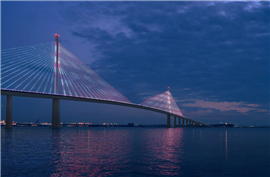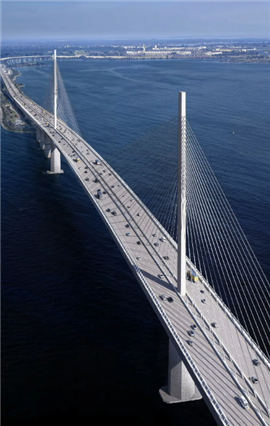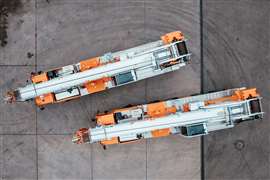Webuild proposes new design for reconstruction of Baltimore’s collapsed Francis Scott Key bridge
03 May 2024
 A digital image of Webuild’s proposed design for the reconstruction of the collapse Francis Scott Key bridge (Image: Webuild)
A digital image of Webuild’s proposed design for the reconstruction of the collapse Francis Scott Key bridge (Image: Webuild)
Italian construction group Webuild and its US subsidiary Lane have presented the design for a new cable-stayed bridge to replace the collapsed Francis Scott Key bridge in Baltimore, USA.
The bridge collapsed after it was struck by a container ship in March this year. Five construction workers who had been working on the bridge at the time of its collapse are now confirmed with one still missing, presumed dead.
Webuild said it had offered a proposal for the design and planning of reconstruction of the bridge on a pro bono basis.
The preliminary proposal has been drafted in collaboration with architect Carlo Ratti, professor at the Massachusetts Institute of Technology (MIT) and French structural engineer Michel Virlogeux.
 A digital image of Webuild’s proposed design for the reconstruction of the collapse Francis Scott Key bridge (Image: Webuild)
A digital image of Webuild’s proposed design for the reconstruction of the collapse Francis Scott Key bridge (Image: Webuild)
Webuild rebuilt the new Genoa Bridge in Italy in around a year, following the collapse of the original bridge in 2018, which resulted in the deaths of 43 people.
Its proposal for Baltimore includes a cable-stayed bridge that aims to improve safety, sustainability and adaptability, it said.
The bridge’s design would increase the navigable clearance, the space that a ship can occupy to pass under the bridge, to 213 feet (65m). The bridge span would also be enlarged to about 2,300 feet (700m), with the main pylons positioned in shallower water and away from the navigation channel.
The plan also incorporates a wider carriageway, with the increase of one lane in each direction and a widening of the emergency lanes, in response to increased traffic levels on the bridge, as well as sustainable materials.
Architect Carlo Ratti, a professor at Massachusetts Institute of Technology (MIT), has presented studies on the structural monitoring of bridges through MIT’s Senseable City Lab ‘Good Vibrations’ project. Virlogeux has worked on major cable-stayed bridges in Europe, including the Vasco da Gama bridge in Lison, Portugal, and the world’s highest bridge, the Millau Viaduct in France.
“We at Webuild and our US subsidiary Lane are ready to make ourselves available, to quickly restore this strategic bridge for local mobility,” said Webuild CEO Pietro Salini in a letter sent with the project to the US Secretary of Transportation, the Governor of Maryland, the director of the Maryland Port Administration and the US Ambassador to Italy.
“We will take part, on 7 May, in the Maryland Transportation Authority (MDTA)’s Virtual Industry Forum for the reconstruction of the bridge, and we are ready to help in any way we can at this stage in the spirit of pro bono service. The design concept of the bridge that we have been working on incessantly during this last month will represent a key contribution towards the design and reconstruction or new construction of the bridge”.
Ratti added, “Opting for a cable-stayed solution enables the piles to be positioned at a safe distance, well away from the navigation channel used by large vessels and hence preventing the risk of a tragedy such as the one of 26 March happening again. This approach also provides a light-weight solution to reconnect two sides of Baltimore, both socially and economically - what American infrastructure should be striving to do in the 21st century.”




